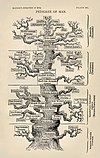IntroductionThe Carboniferous (/ˌkɑːrbəˈnɪfərəs/ KAR-bə-NIF-ər-əs) is a geologic period and system of the Paleozoic that spans 60 million years from the end of the Devonian Period 358.9 Ma (million years ago) to the beginning of the Permian Period, 298.9 Ma. In North America, the Carboniferous is often treated as two separate geological periods, the earlier Mississippian and the later Pennsylvanian. The name Carboniferous means "coal-bearing", from the Latin carbō ("coal") and ferō ("bear, carry"), and refers to the many coal beds formed globally during that time. The first of the modern "system" names, it was coined by geologists William Conybeare and William Phillips in 1822, based on a study of the British rock succession. Carboniferous is the period during which both terrestrial animal and land plant life was well established. Stegocephalia (four-limbed vertebrates including true tetrapods), whose forerunners (tetrapodomorphs) had evolved from lobe-finned fish during the preceding Devonian period, became pentadactylous during the Carboniferous. The period is sometimes called the Age of Amphibians because of the diversification of early amphibians such as the temnospondyls, which became dominant land vertebrates, as well as the first appearance of amniotes including synapsids (the clade to which modern mammals belong) and sauropsids (which include modern reptiles and birds) during the late Carboniferous. Land arthropods such as arachnids (e.g. trigonotarbids and Pulmonoscorpius), myriapods (e.g. Arthropleura) and especially insects (particularly flying insects) also underwent a major evolutionary radiation during the late Carboniferous. Vast swaths of forests and swamps covered the land, which eventually became the coal beds characteristic of the Carboniferous stratigraphy evident today. The later half of the period experienced glaciations, low sea level, and mountain building as the continents collided to form Pangaea. A minor marine and terrestrial extinction event, the Carboniferous rainforest collapse, occurred at the end of the period, caused by climate change. Altough the period is often asserted to have had higher atmospheric oxygen concentration than at present, estimates of prehistoric atmospheric oxygen concentrations are subject to considerable uncertainty, with some studies recovering atmospheric oxygen levels similar or lower than present values. (Full article...) Selected natural world article
Ctenophora is a phylum of marine animals characterized by "combs" consisting of cilia they use for swimming. Adults range from a few millimeters to 1.5 m (4 ft 11 in) in size. Their bodies consist of a mass of jelly, with one layer two cells thick on the outside and another lining the internal cavity. Almost all ctenophores consume tiny animal prey. The phylum has a wide range of body forms, including the egg-shaped cydippids with retractable tentacles that capture prey, the flat generally combless platyctenids, and the large-mouthed beroids, which prey on other ctenophores.
Despite their soft, gelatinous bodies, fossils thought to represent ctenophores have been found in lagerstätten as far back as the early Cambrian, about 525 million years ago. The position of the ctenophores in the tree of life has long been debated, and the majority view at present, based on molecular phylogenetics, is that ctenophores are more primitive than the sponges, which are more primitive than the cnidarians and bilaterians. A recent molecular phylogenetics analysis concluded that the common ancestor of all modern ctenophores was cydippid-like, and that all the modern groups appeared relatively recently, probably after the Cretaceous–Paleogene extinction event 66 million years ago. Evidence accumulating since the 1980s indicates that the "cydippids" are not monophyletic, in other words do not include all and only the descendants of a single common ancestor, because all the other traditional ctenophore groups are descendants of various cydippids. (see more...) Did you know...
Need help?Do you have a question about Abyssal/Portal:Carboniferous that you can't find the answer to? Consider asking it at the Wikipedia reference desk. Selected image
Selected science, culture, or economics article In 1858, Charles Darwin and Alfred Russel Wallace published a new evolutionary theory that was explained in detail in Darwin's On the Origin of Species (1859). Unlike Lamarck, Darwin proposedcommon descent and a branching tree of life. The theory was based on the idea of natural selection, and it synthesized a broad range of evidence from animal husbandry, biogeography, geology, morphology, and embryology. The debate over Darwin's work led to the rapid acceptance of the general concept of evolution, but the specific mechanism he proposed, natural selection, was not widely accepted until it was revived by developments in biology that occurred during the 1920s through the 1940s. Before that time most biologists argued that other factors were responsible for evolution. The synthesis of natural selection with Mendelian genetics during the 1920s and 1930s founded the new discipline of population genetics. Throughout the 1930s and 1940s, population genetics became integrated with other biological fields, resulting in a widely applicable theory of evolution that encompassed much of biology—the modern evolutionary synthesis. (see more...) GeochronologyEpochs - Mississippian - Pennsylvanian Landmasses - Gondwanaland - Laurasia - Pangaea Fossil sites - Bear Gulch Limestone - Hamilton Quarry - Mazon Creek fossil beds Researchers - Alfred Sherwood Romer
SubcategoriesQuality ContentFeatured Carboniferous articles - Amphibian Things you can doRelated contentAssociated WikimediaThe following Wikimedia Foundation sister projects provide more on this subject:
|




















